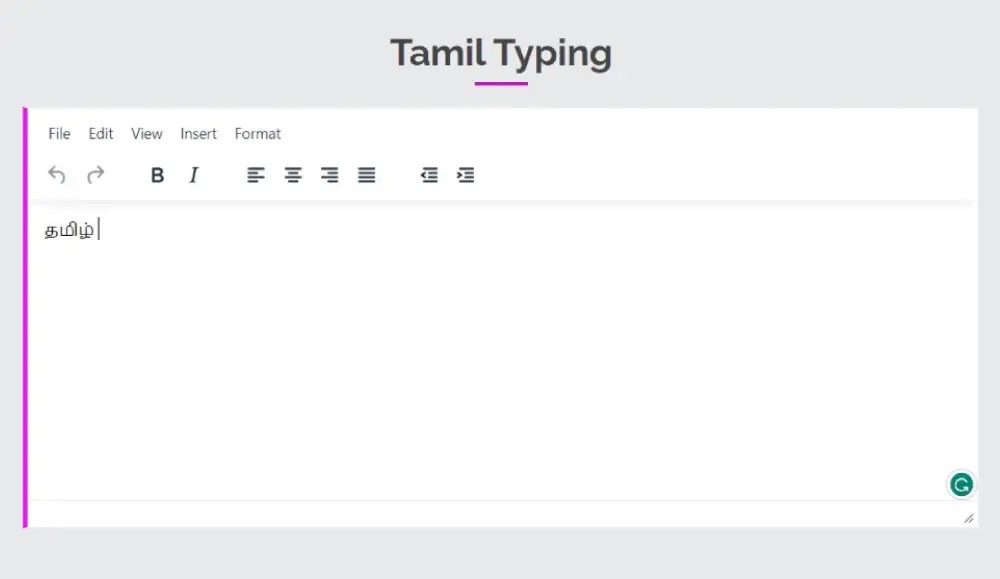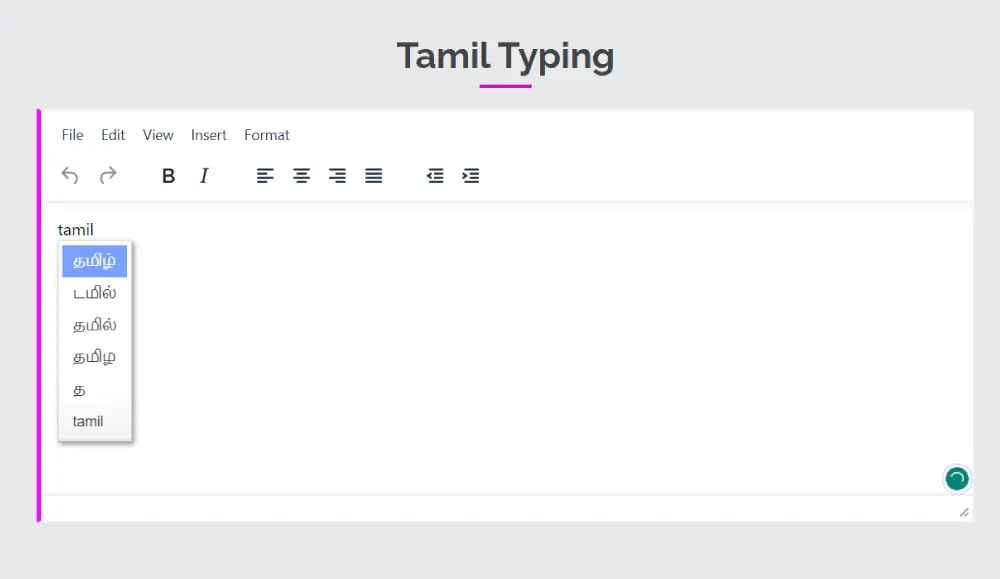Get Started with Our Tamil Typing Tool
Our Tamil typing tool makes it easy to type in Tamil without any technical knowledge or software downloads. All you need to do is visit our website and start typing! Our intuitive layout ensures that you`ll be able to quickly navigate the page and get started with your typing. Best of all, you don`t have to worry about accuracy - our tool will automatically detect and correct mistakes as you type! In mobile when you type in all the given text-area space, your content fills the text-area and if you want to increase the size of the text area, you can expand its size each time you press the button EXPAND and after completion and start a new content typing press the button SHRINK and the text area will be back to its original size. On the desktop, once the text has been typed into the desired language, all you need to do is select it all, press “ctrl-c,” copy it, and then press “ctrl-v” to paste it back into your document. When you are on mobile just simply click the COPY button and copy all your text and then paste it into your desired location. And also clear your text area after typing press the CLEAR button and you can type other contents as you like.
Unable to find the correct transliterate?


Tamil Language
Tamil is a Dravidian language spoken primarily in the southern Indian state of Tamil Nadu and the Union Territory of Puducherry (Pondicherry) by the Tamil people. It is also spoken by significant minorities in the neighboring states of Kerala, Karnataka, and Andhra Pradesh, as well as emigrant communities around the world. It is one of the longest-surviving classical languages in the world, with a literary tradition spanning more than 2000 years. The Tamil script, an abugida, is derived from the Brahmi script and is written from left to right. Tamil is a diglossic language, meaning that there is a distinction between the formal, literary language and the colloquial, spoken language. The Tamil language has a rich literary tradition, with ancient texts such as the Sangam literature, which dates back to the 3rd century BCE, as well as more modern works in poetry, fiction, and drama.
History of Tamil
The Tamil language has a rich and ancient history. The earliest records of the language can be found in inscriptions from the 3rd century BCE, which have been found in various parts of southern India. The earliest literary works in Tamil, known as Sangam literature, dating back to this period as well. These works were written by a group of poets known as the Sangam poets and covered a wide range of subjects, including love, war, and religion.
Tamil was heavily influenced by the languages of the neighboring civilizations, such as the Prakrit and Sanskrit languages of the North Indian kingdoms, and the Pali language of Buddhism. These influences are evident in the development of the Tamil script, which is derived from the Brahmi script, as well as in the incorporation of many loanwords from these languages into Tamil.
During the medieval period, Tamil was the language of the powerful Chola and Pandya empires, and it continued to be a dominant language in the region. In the 19th century, the British colonial government recognized Tamil as one of the official languages of the region, along with Telugu and Kannada.
Today, It is spoken by approximately 78 million people worldwide and is one of the 22 official languages of India. It is also an official language in Sri Lanka and Singapore, and it is recognized as a minority language in Malaysia and Mauritius. Tamil is a language that has a rich cultural and literary heritage, and it continues to play a vital role in the lives of the Tamil-speaking people.
Tamil Script (தமிழ் எழுத்து)
Consonants (தமிழ் எழுத்து)
க ங ச ஞ ட ண த ந ப ம ய ர ல வ ழ ள ற ன
Vowels (உயிரெழுத்துக்கள்)
அ ஆ இ ஈ உ ஊ எ ஏ ஐ ஒ ஓ ஔ
Special Character (சிறப்பு பாத்திரம்)
ஃ (ayudham)
Numbers (எண்கள்)
௦(0), ௧(1), ௨(2), ௩(3), ௪(4), ௫(5), ௬(6), ௭(7), ௮(8), ௯(9), ௰(10), ௱(100), ௲(1000)
Transliterate English to Tamil
Our online typing system will allow you to transliterate English into Tamil. We use the Google transliterate feature to translate, which is very fast and accurate. You can simply convert each word, just press the space bar after typing them. Also, you can get a choice option dropdown if you press the back key. You can edit your text with a text editor to bold, italic etc. Format and style all your converted Tamil content. We use some autocorrection features to transliterate your broken words without retyping them. Which saves you more time in typing.
Press (Ctrl+G) to switch between English and Tamil. Also, you can save them as txt or doc for your further use.
Translate vs Transliterate
Translation refers to the process of converting written text from one language to another while preserving the meaning of the original text. Translation involves converting the words and phrases of a text from one language to their equivalents in another language, taking into account the context and cultural differences between the languages.
Transliteration, on the other hand, refers to the process of converting written text from one script (alphabet or writing system) to another, while preserving the sounds of the original text. Transliteration involves converting the letters and characters of a text from one script to their equivalents in another script, without necessarily preserving the meanings of the words.
For instance, the Tamil equivalent of the English phrase "Hello, how are you?" is "வணக்கம் எப்படி இருக்கிறாய்?" This translation keeps the original phrase`s meaning. On the other hand, the English phrase "Hello, how are you?" can be transliterated into the Tamil alphabet as "ஹலோ, ஹொவ் ஆர் யு?", which preserves the sounds of the original phrase but not necessarily it`s meaning.
Translation and transliteration are both useful tools for helping people communicate and understand written text in different languages and scripts. However, they serve different purposes and involve different approaches to converting written text.
